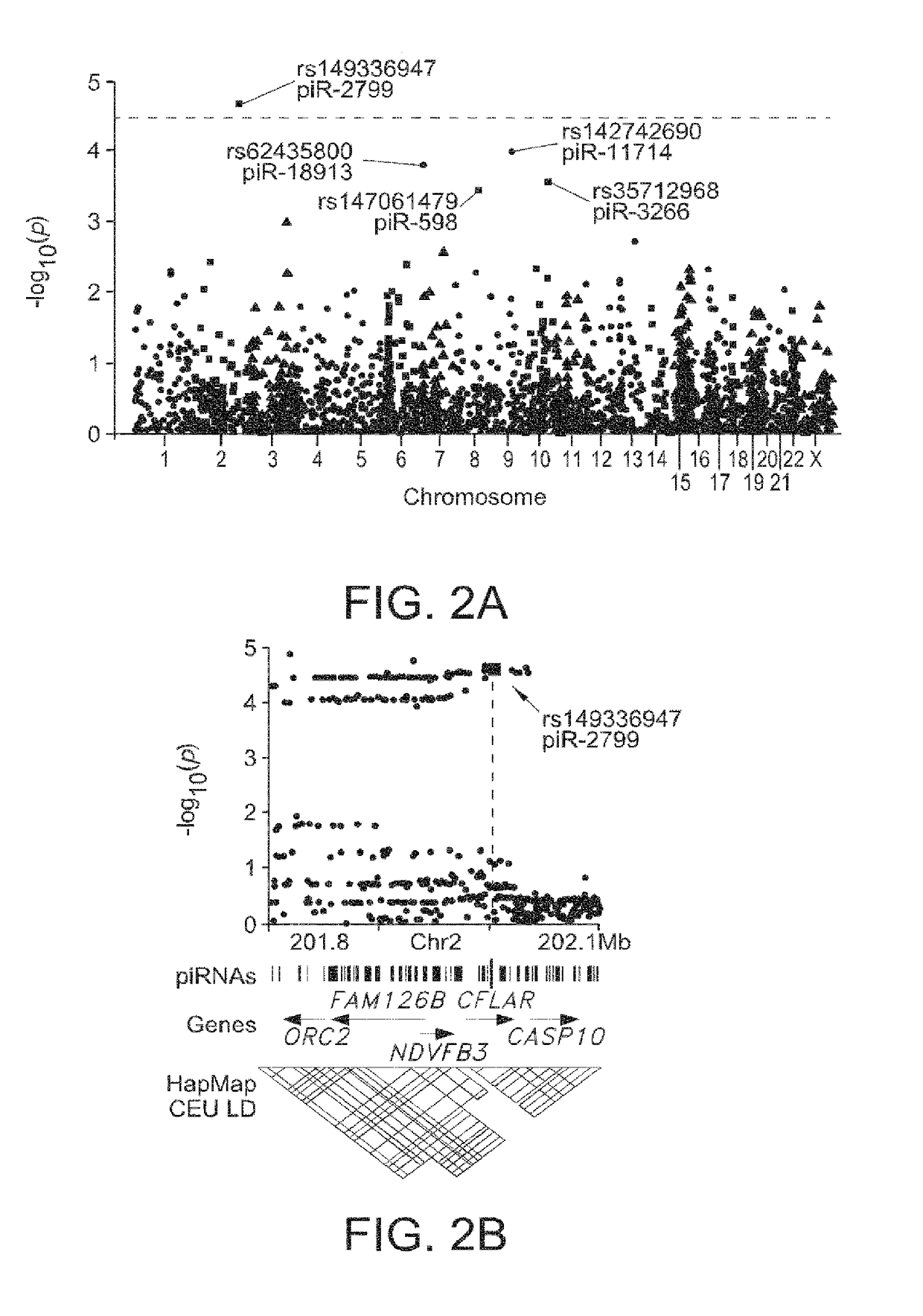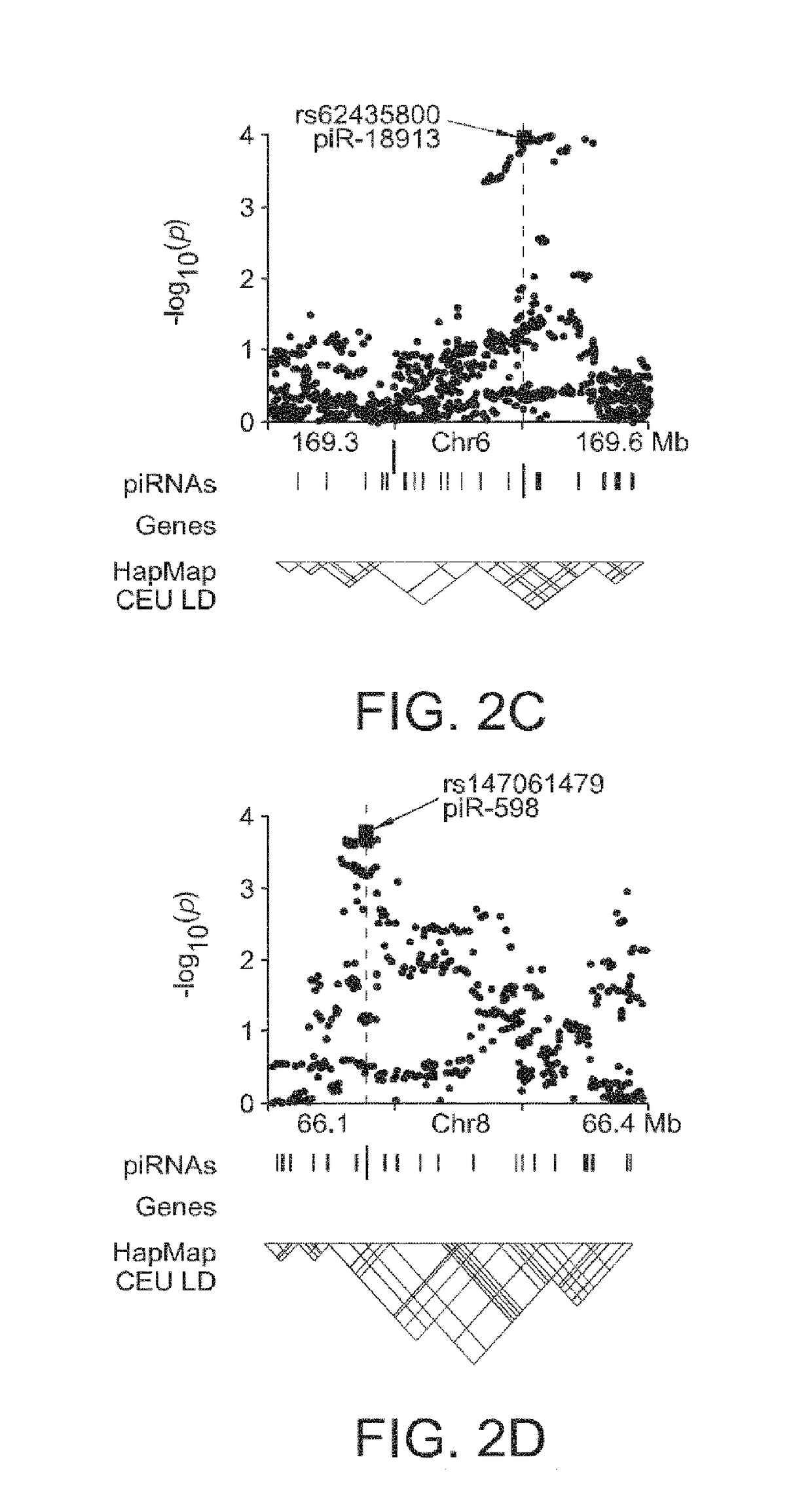COMPOSITIONS AND METHODS OF USING piRNAS IN CANCER DIAGNOSTICS AND THERAPEUTICS
- Summary
- Abstract
- Description
- Claims
- Application Information
AI Technical Summary
Benefits of technology
Problems solved by technology
Method used
Image
Examples
example 1
Glioma-Associated piRNAs Identified by Post-GWAS Analysis
[0239]It was estimated that nearly 23,400 new cases of primary malignant brain and central nervous system (CNS) tumors would be diagnosed in the United States in 2014; of those, approximately 2,240 would be diagnosed in children ages 0 to 14 years and 540 would be diagnosed in adolescents ages 15 to 19 years. Overall mortality rates have not changed significantly in the past decade. Both incidence and mortality rates are higher for whites than for people of other racial / ethnic groups. In all racial / ethnic groups, men have higher incidence and mortality rates than women. Brain tumors are the leading cause of death from solid tumor cancers in children. Brain and CNS tumors make up approximately 21 percent of all childhood cancers. The incidence rate of brain and CNS cancers in children has been relatively stable since the mid-1980s, but the death rate has dropped over this period.
[0240]The causes of most brain and CNS cancers ar...
example 2
Glioma-Related piRNAs Identified by Expression Profiling Analysis
[0281]The PIWI-piRNA pathway has been demonstrated to play a highly conserved regulatory role in transposon suppression in germline stem cells. While its significance outside of this context remains largely enigmatic, there has been striking consistency in findings that PIWI-family proteins are ectopically expressed and associated with worse outcomes across a wide array of cancer types, and more recently that piRNAs are expressed in tumor type-specific patterns that differ markedly from corresponding normal tissues. However, no information has been reported to date on the nature of piRNA expression in many cancer types, including glioma, and the functional implications of dysregulated piRNA expression are largely unelucidated. The results in the following examples demonstrate that a subset of piRNAs are expressed in neuroglial tissue including some that are differentially expressed in GBM relative to normal brain tissu...
example 3
In Vitro Anti-Tumor Effects of Identified piRNAs from Expression Analysis
[0298]Materials and Methods
[0299]Cell Viability and Soft Agar Assays
[0300]For cell viability, cells were reverse transfected with piRNA or negative control oligos and color development was evaluated one hour after addition of MTS (Promega) using a microplate spectrophotometer. For soft agar assays, cells were reverse transfected with piRNA or negative control oligos. After 24 hours, cells were re-suspended in warmed culture medium with 0.36% agar and seeded in 60 mm dishes above a base layer of 0.75% agar. Colonies were stained with 0.04% crystal violet-2% ethanol in PBS after three weeks and counted using ImageJ v1.48 software. Experiments were performed in triplicate and differences of viability and colony number were analyzed using a Student's t-test.
[0301]Genome-Wide Transcriptome Profiling
[0302]RNA profiling of piR-8041- or control RNA-transfected U87 cells, 24 hours post-transfection, was performed on the...
PUM
| Property | Measurement | Unit |
|---|---|---|
| Fraction | aaaaa | aaaaa |
| Fraction | aaaaa | aaaaa |
| Fraction | aaaaa | aaaaa |
Abstract
Description
Claims
Application Information
 Login to View More
Login to View More - R&D
- Intellectual Property
- Life Sciences
- Materials
- Tech Scout
- Unparalleled Data Quality
- Higher Quality Content
- 60% Fewer Hallucinations
Browse by: Latest US Patents, China's latest patents, Technical Efficacy Thesaurus, Application Domain, Technology Topic, Popular Technical Reports.
© 2025 PatSnap. All rights reserved.Legal|Privacy policy|Modern Slavery Act Transparency Statement|Sitemap|About US| Contact US: help@patsnap.com



